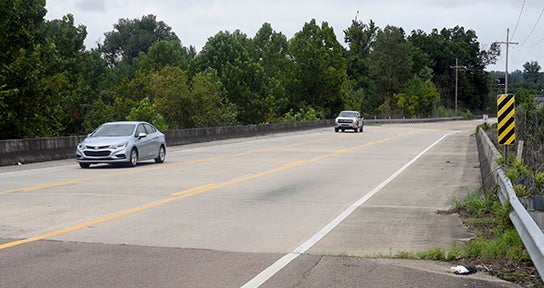Officials look for way to prevent Hennessey Bayou from rerouting
Published 7:41 pm Saturday, September 15, 2018

- Vehicles pass over the bridge that is over Hennessey Bayou on Warrenton Road. Officials say fixing the bank at the Warren Road bridge is a priority to prevent it from possibly collapsing like the Kemp Bottom Road bridge in 2017. (Courtland Wells/The Vicksburg Post)
In July 2017, the Kemp Bottom Road bridge over Hennessey Bayou collapsed, cutting off the main route to Entergy Mississippi’s Baxter Wilson power plant, and forcing the city to find a way to replace the bridge and reopen the city road.
But the problem is more serious than replacing a bridge to reopen a road. Hennessey Bayou, which drains into the Mississippi River, is seeking a shorter route to the river, and eroding the banks of its present channel as it seeks its new route.
And if the problem is not corrected, it will threaten some of the towers holding transmission lines from Baxter Wilson that carry electricity to other parts of the state, and another city bridge on Warrenton Road.
“It was a function of the 2011 flood that got it started,” said Tom Shaw, chief of the project management branch at the U.S. Army Corps of Engineers Vicksburg District. “There are several areas that have everybody’s interest, and the last thing that we want it to do is to have it walk back up to the Warrenton Road Bridge.”
When the 2011 spring Mississippi River flood, which crested on May 19, 2011, at 57.1 feet, 14.1 feet above flood stage and nine-tenths of a foot above the Great Flood of 1927, hit the area, the bayou began looking for a shorter route to the river.
Engineers said the water entering Hennessy’s Bayou during the flood receded quickly and created the present erosion problem that caused the bridge to collapse.
Working together
The Corps and the city of Vicksburg in April, signed an agreement enabling the Corps to help the city develop a plan to stabilize Hennessy Bayou’s west bank. Under the agreement, the city and the Corps will split the study’s $75,000 cost.
Shaw said the report of the Corps’ study is expected to be ready by the first quarter of the 2019 fiscal year, which begins Oct. 1, adding the report is being reviewed by Corps officials.
The Board of Mayor and Aldermen on Sept. 4 applied to the National Resource Conservation Service for the money, which will pay 75 percent, or $1.6 million, of the estimated $2.21 million project to fix the erosion problem. The city’s share is $554,687.
Entergy spokeswoman Mara Hartmann said Entergy will assist the city with its match.
Stabilizing the bank
Shaw said the report will include recommendations to stabilize the bank and the Corps will provide technical recommendations for corrective action.
“The intent is to look at the overall bank,” he said. “We’ve got to stop the head cutting and prevent it from moving back up the channel.”
Head cutting, he said, is erosion caused by the difference in elevation between an inlet and an outlet of a stream.
“It’s the erosion process that happens from downstream to upstream on a moving body of water,” Shaw said. “That energy has to be dissipated somewhere. Anything falling, you’ve got the energy that’s associated with gravity.”
The most common resolution he said, is “rocking the channel;” stabilizing the bank by putting stone on the banks of the stream and in the channel (bed) to keep it in its present channel.
“That’s a bank stabilization process,” he said. “We will be looking for ways to keep it inside its present banks and present course.”
A priority
Whatever recourse is recommended for the bayou, Garnet Van Norman, public works director and city engineer, said fixing the bank along the Warrenton Road bridge will be a priority.
“The main thing we want to do it make sure the Warrenton Road bridge is safe so it won’t go out,” he said. “If it’s not fixed, it (the bridge) will fall out, just like the Kemp Bottom Road Bridge.”
And while there is presently no severe erosion near the bridge, he said, “We’re trying to get to it before it happens. I inspected the bridge the time Kemp Bottom Road fell in, and everything was OK.”






